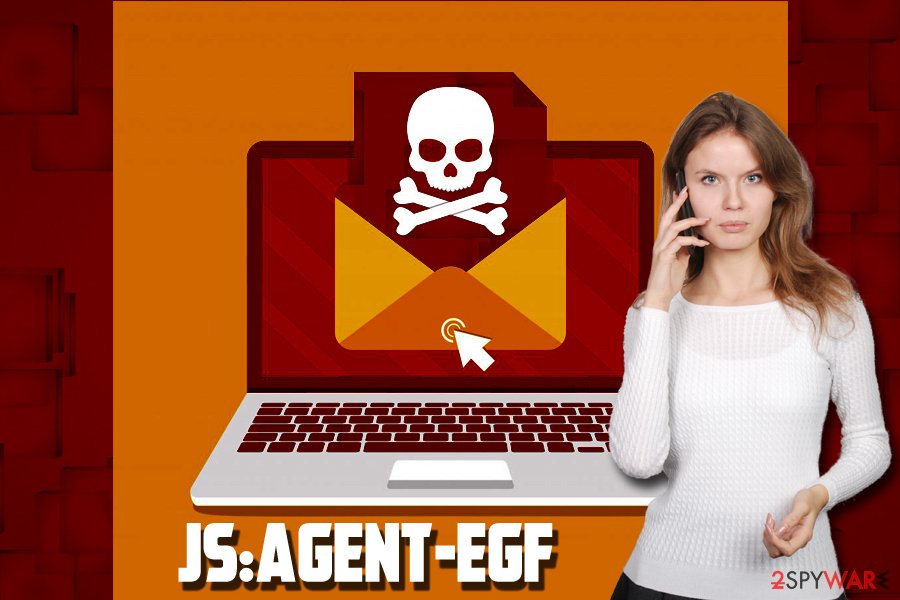JS:Agent-EGF (Removal Guide) - Free Instructions
JS:Agent-EGF Removal Guide
What is JS:Agent-EGF?
JS:Agent-EGF is malware that is capable of downloading other malicious files onto the host PC

JS:Agent-EGF is a type of malicious software that uses JavaScript[1] (JS) to perform its actions. The malware can be obtained when visiting malicious or hacked websites, although victims reported that the infection occurred after they opened a malicious attachment in the spam email.[2] Hackers often employ social engineering to make users click on a malware-laden link. Once executed, JS:Agent-EGF [adw] performs changes to the system and starts downloading other malicious files, such as trojans or cryptominers. This malicious activity can download and install virtually anything, so it is vital not to ignore warnings from anti-virus software.
| Name | JS:Agent-EGF |
| Category | Malware |
| Type | Trojan downloader |
| Distribution | Malicious websites, spam emails |
| Symptoms | Usually none, but users might experience system slowdowns, crashing programs, etc. |
| Elimination | Use potent security software |
| Optimization | Scan your device with FortectIntego |
Once the JS:Agent-EGF virus is installed, it will contact a remote server that is controlled by hackers. This provides the opportunity to malicious actors to run scripts via Windows desktop, Windows Explorer, and Windows command prompt. Unfortunately, JS-based malware is often very hard to detect unless adequate security software is used. After JS:Agent-EGF removal, we recommend scanning the system with FortectIntego to recover from virus damage.
Due to modification to Windows Registry,[3] JS:Agent-egf [adw] can also read and send out the information that it acquires through the compromised computer. Therefore, such details as banking information, logins to various accounts might be compromised.
While in most cases users will not see any changes to their PCs after clicking on a malicious JS Agent EGF file, in some cases, victims can experience the following:
- Slow operation of the computer;
- The appearance of new programs that were not installed by the user;
- Crashing applications;
- Random system restarts;
- Frequent BSoDs;
- Redirects to suspicious websites when using Google Chrome, Internet Explorer, Mozilla Firefox, or another browser.
Be aware that symptoms might vary, or be not present at all. Therefore, if you think that your machine might be infected with JS:Agent-EGF, you should immediately install security software and perform a full system scan. Powerful anti-virus software will be able to remove JS:Agent-EGF relatively quickly.

Install powerful security software and patch your system to prevent infection
As we already mentioned, this particular threat mostly uses malicious websites to enter users' computers. Nevertheless, it can also be spread with the help of spam email attachments or links, as well as by abusing old system vulnerabilities.
Therefore, it is vital to perform the following steps in order to avoid the infection of trojans and other malware:
- Download and install robust security software that would be able to stop the threat before the malicious script is run;
- Make sure your operating system and other applications are updated with the latest security patches;
- Stop JavaScript by running automatically and enable click-to-run function so you would know when JS is being executed;
- Do not casually open spam emails or click on links;
- Backup your files regularly;
- Avoid visiting file-sharing and torrent sites – these often host malicious files.
Remove JS Agent EGF malware from your machine with the help of powerful anti-malware solution
It is vital to perform JS:Agent-EGF removal as soon as possible due to high-risk factors. If not eliminated, the threat and download and install other malicious applications that could harm the system even more, or even result in data loss due to ransomware infection. Therefore, do not ignore the signs and remove JS:Agent-EGF virus using adequate anti-malware solution.
Do not risk removing JS:Agent-egf [adw] manually, as you might damage vital system files and corrupt the machine even more. Once the elimination is complete, we suggest you scan your device with FortectIntego, as it can fix the damage done by the virus, restore Windows Registry and clean the machine properly.
Getting rid of JS:Agent-EGF. Follow these steps
Manual removal using Safe Mode
If malware is interfering with JS:Agent-EGF removal, enter safe environment – Safe Mode with Networking:
Important! →
Manual removal guide might be too complicated for regular computer users. It requires advanced IT knowledge to be performed correctly (if vital system files are removed or damaged, it might result in full Windows compromise), and it also might take hours to complete. Therefore, we highly advise using the automatic method provided above instead.
Step 1. Access Safe Mode with Networking
Manual malware removal should be best performed in the Safe Mode environment.
Windows 7 / Vista / XP
- Click Start > Shutdown > Restart > OK.
- When your computer becomes active, start pressing F8 button (if that does not work, try F2, F12, Del, etc. – it all depends on your motherboard model) multiple times until you see the Advanced Boot Options window.
- Select Safe Mode with Networking from the list.

Windows 10 / Windows 8
- Right-click on Start button and select Settings.

- Scroll down to pick Update & Security.

- On the left side of the window, pick Recovery.
- Now scroll down to find Advanced Startup section.
- Click Restart now.

- Select Troubleshoot.

- Go to Advanced options.

- Select Startup Settings.

- Press Restart.
- Now press 5 or click 5) Enable Safe Mode with Networking.

Step 2. Shut down suspicious processes
Windows Task Manager is a useful tool that shows all the processes running in the background. If malware is running a process, you need to shut it down:
- Press Ctrl + Shift + Esc on your keyboard to open Windows Task Manager.
- Click on More details.

- Scroll down to Background processes section, and look for anything suspicious.
- Right-click and select Open file location.

- Go back to the process, right-click and pick End Task.

- Delete the contents of the malicious folder.
Step 3. Check program Startup
- Press Ctrl + Shift + Esc on your keyboard to open Windows Task Manager.
- Go to Startup tab.
- Right-click on the suspicious program and pick Disable.

Step 4. Delete virus files
Malware-related files can be found in various places within your computer. Here are instructions that could help you find them:
- Type in Disk Cleanup in Windows search and press Enter.

- Select the drive you want to clean (C: is your main drive by default and is likely to be the one that has malicious files in).
- Scroll through the Files to delete list and select the following:
Temporary Internet Files
Downloads
Recycle Bin
Temporary files - Pick Clean up system files.

- You can also look for other malicious files hidden in the following folders (type these entries in Windows Search and press Enter):
%AppData%
%LocalAppData%
%ProgramData%
%WinDir%
After you are finished, reboot the PC in normal mode.
Remove JS:Agent-EGF using System Restore
You can also make use of System Restore to get rid of the virus:
-
Step 1: Reboot your computer to Safe Mode with Command Prompt
Windows 7 / Vista / XP- Click Start → Shutdown → Restart → OK.
- When your computer becomes active, start pressing F8 multiple times until you see the Advanced Boot Options window.
-
Select Command Prompt from the list

Windows 10 / Windows 8- Press the Power button at the Windows login screen. Now press and hold Shift, which is on your keyboard, and click Restart..
- Now select Troubleshoot → Advanced options → Startup Settings and finally press Restart.
-
Once your computer becomes active, select Enable Safe Mode with Command Prompt in Startup Settings window.

-
Step 2: Restore your system files and settings
-
Once the Command Prompt window shows up, enter cd restore and click Enter.

-
Now type rstrui.exe and press Enter again..

-
When a new window shows up, click Next and select your restore point that is prior the infiltration of JS:Agent-EGF. After doing that, click Next.


-
Now click Yes to start system restore.

-
Once the Command Prompt window shows up, enter cd restore and click Enter.
Finally, you should always think about the protection of crypto-ransomwares. In order to protect your computer from JS:Agent-EGF and other ransomwares, use a reputable anti-spyware, such as FortectIntego, SpyHunter 5Combo Cleaner or Malwarebytes
How to prevent from getting malware
Protect your privacy – employ a VPN
There are several ways how to make your online time more private – you can access an incognito tab. However, there is no secret that even in this mode, you are tracked for advertising purposes. There is a way to add an extra layer of protection and create a completely anonymous web browsing practice with the help of Private Internet Access VPN. This software reroutes traffic through different servers, thus leaving your IP address and geolocation in disguise. Besides, it is based on a strict no-log policy, meaning that no data will be recorded, leaked, and available for both first and third parties. The combination of a secure web browser and Private Internet Access VPN will let you browse the Internet without a feeling of being spied or targeted by criminals.
No backups? No problem. Use a data recovery tool
If you wonder how data loss can occur, you should not look any further for answers – human errors, malware attacks, hardware failures, power cuts, natural disasters, or even simple negligence. In some cases, lost files are extremely important, and many straight out panic when such an unfortunate course of events happen. Due to this, you should always ensure that you prepare proper data backups on a regular basis.
If you were caught by surprise and did not have any backups to restore your files from, not everything is lost. Data Recovery Pro is one of the leading file recovery solutions you can find on the market – it is likely to restore even lost emails or data located on an external device.
- ^ JavaScript Malware Finds New Life. Sophos. Cybersecurity blog.
- ^ Margaret Rouse . Email virus. SearchSecurity. Information Security information, news and tips.
- ^ Windows Registry. Wikipedia. The Free Encyclopedia.





















